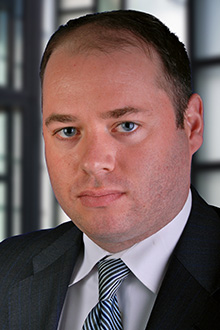New York Transportation Team Update - June 2020

New York, N.Y. (June 11, 2020) - Lewis Brisbois’ Transportation Team has the deepest bench of experienced transportation lawyers in the nation.
Our attorneys have extensive proven experience defending transportation clients across the country. We move quickly and aggressively to pursue every available tactical advantage for our clients. In this update, we share some recent representative wins from our New York Transportation Team. This sampling of recent wins involve summary judgment motions being granted, defense verdicts at trial, and wins in the Appellate Division by our Appellate Team.
These victories, secured for a variety of transportation clients in some of the most plaintiff-friendly jurisdictions in the country, demonstrate our successful strategy of working closely with our clients and carriers to develop detailed and well-tailored strategies to get the early upper hand on our adversaries at trial. This proven strategy has saved our clients millions over the years. Of course, when going to trial is unavoidable, our clients know they can rely on Lewis Brisbois’ unmatched trial experience to ensure the very best result is obtained on every trial.
Supporting this team’s impressive trial work are the members of our National Transportation Practice Group who are on standby 24/7 to take calls from transportation companies and insurers when accidents occur anywhere in the country. Our attorneys manage on-scene accident investigations to assure both the preservation of evidence and attorney-client privilege. We work with teams of seasoned investigators and experts who specialize in the collection and analysis of accident evidence and, together, evaluate the physical and human factors that contribute to the cause of an accident. Learn more about this 24/7 Rapid Response Team here.
While courts have been closed around the country, we are working with clients to resolve cases on the most favorable terms. On those cases that cannot be settled, we are working closely with our insured and experts to be better prepared for when the courtrooms across the state reopen.
Continue reading for a sampling of the fantastic work our New York Transportation Team has been doing for clients in the metro area, plus a timely analysis from Partner Nicholas P. Hurzeler about how employers in the trucking industry can use New York’s workers’ comp law in defending against personal injury claims that may arise from the coronavirus pandemic.
Visit our Transportation Practice page to find out more about how this team can help you.
New York Transportation Team Secures Dismissal of Three Related BI Claims By Filing a Summary Judgment Motion Prior to Depositions, Using Video Evidence and Affidavits
New York Partners Adam N. Schwartzstein and Meredith Drucker Nolen recently were successful in obtaining summary judgment granting dismissal of three different claims and lawsuits in one fell swoop, prior to the deposition phase. In the underlying matter, three separate plaintiff alleged injuries following an accident between their automobile and our client’s bus. The first plaintiff claimed right shoulder tears and right knee tears, both requiring surgery; the second plaintiff claimed cervical and lumbar bulges and radiculopathy, lumbar percutaneous discectomy, cervical percutaneous discectomy, and several lumbar and cervical epidural steroid injections; and the third plaintiff claimed shoulder tears with injections and herniations.
Our motion for summary judgment on the issue of liability was prepared and filed before depositions were conducted, as our attorneys developed the evidential record and determined there was enough to prepare such a motion before even needing to conduct depositions. In support of our motion, we submitted video of the accident from multiple different angles obtained from the bus involved in the accident. We also submitted a detailed affidavit signed by the bus driver that we prepared immediately following our meeting with him. In an attempt to avoid motion practice, we proffered a stipulation of discontinuance to all three plaintiffs requesting a voluntary discontinuance against our client, which they refused to sign, believing they could defeat our motion and eventually prove some degree of negligence (at least 1%) to keep our bus operator client in the case.
In its lengthy decision, the court stated that our requested dismissal was warranted based on the bus driver’s sworn affidavit, buttressed by the video evidence showing that the bus driver had the right of way, had no traffic device, and was free of fault. The court specifically referred to the clear language of the bus driver’s affidavit, which made plain that she would have been unable to take evasive action, or any other action for that matter. There was no possible alternative interpretation of the events of the accident as depicted in the video, particularly when combined with the bus driver’s affidavit.
This excellent result continues to serve as notice to the plaintiffs’ bar that Lewis Brisbois’ trial attorneys will take early aggressive action to seek dismissal of matters, especially in cases where video of the accident exists and can be supported by a well-prepared driver’s affidavit.
New York Transportation Team Obtains Summary Judgment In Case Involving Plaintiff Falling Down While Bus Pulled Away From Sidewalk
New York Partners Adam N. Schwartzstein, Meredith Ross Friedler, and Meredith Drucker Nolen were recently successful in obtaining summary judgment in a slip-and-fall action brought against a bus company and the bus driver. The plaintiff claimed that she slipped and fell in the defendants’ bus as it pulled away from a bus stop while she was walking to a seat. According to the plaintiff, the defendants’ bus driver was negligent in allowing a wet and slippery condition to exist on the floor of the bus and was also negligent in his operation of the bus when he pulled out from the bus stop before the plaintiff was able to get to a seat.
In granting our motion for summary judgment, the judge found that the defendants had established prima facie entitlement to summary judgment on both claims. First, with respect to whether or not the defendants had actual or constructive notice of the wet condition on the floor and a sufficient time to remedy the condition, the court noted that the plaintiff admitted that it was “pouring rain” at the time of the accident and that she did not see the wet condition on the floor immediately prior to her fall. Video surveillance submitted by the defendants from inside the bus confirmed that there was an “ongoing storm” as the plaintiff was carrying an umbrella, rain was falling on the windshield at the time of the accident and the windshield wipers on the bus were in constant motion at the time. As such, the court found that the plaintiff, in opposition, did not demonstrate that the condition was “visible or apparent” or that the condition existed for a sufficient period of time to discover and remedy the condition. As the court noted, the water could have been dropped by passengers that boarded just prior to the plaintiff, or even by the plaintiff herself, as the bus driver indicated that the plaintiff was dripping when she boarded.
This portion of the court’s decision reiterates the importance of questioning a plaintiff about the weather conditions at the time of the accident. The court’s findings also demonstrate how video surveillance can be used to limit the ability of a plaintiff to alter testimony given at a 50-h hearing or deposition in an attempt to raise a genuine triable issue of fact.
Of particular importance is the fact that the court in this case implicitly rejected the plaintiff’s claim that the “storm in progress” doctrine only applies to snow and ice conditions, and not to what the plaintiff characterized as “ordinary rain.”
Second, the video surveillance was vital in establishing, prima facie, that the bus operator did not negligently pull out of the bus stop after the plaintiff boarded. The video, in conjunction with the bus operator’s deposition testimony that he looked to ensure there were no oncoming vehicles as he merged into traffic and that he operated the bus slowly (five miles per hour) that day due to the weather conditions, demonstrated that the movement of the bus was not “unusual or violent.” In opposition, the plaintiff’s mere characterization of the movement of the bus as a “jerk” and her testimony that the bus “took off” were insufficient to raise a genuine triable issue of fact regarding whether the movement of the bus was of a different class from the normal jolts and movements usually experienced on city bus travel. The plaintiff did not offer any specific testimony regarding the speed of the bus, or the specific “unusual and violent” maneuvers made by the bus driver when he moved the bus out from the bus stop.
In its decision, the court noted that the video showed that the plaintiff did not hold onto any of the available railings on the bus as she boarded or moved to her seat. This decision is in line with many prior appellate court cases that a plaintiff must be descriptive regarding the operation of the bus in order to raise a genuine triable issue of fact in opposition to a motion for summary judgment.
This is a another terrific result that also serves notice to the plaintiffs’ bar that Lewis Brisbois’ trial attorneys will aggressively defend cases where plaintiffs allege injuries after falling on a bus during the normal and usual operations of the bus, by utilizing persuasive video evidence from inside the bus and properly preparing drivers ahead of deposition testimony.
New York Trial Team Obtains Summary Judgment for Ambulette Company Facing $1 Million Plaintiff Demand
New York Partners Sydney S. Sanchez and Nicholas P. Hurzeler recently obtained summary judgment in New York’s Rockland County in a high-exposure matter involving an elderly plaintiff who claimed bilateral hip fractures as a result of an ambulette accident. In addition to granting our motion, the court also denied the plaintiff’s cross-motion for summary judgment. Before the court’s decision, the plaintiff had demanded $1 million to settle the case.
The plaintiff was a patient with numerous mental and physical disabilities, including Alzheimer’s. During a routine ambulette ride, the plaintiff became agitated and started foaming at the mouth, so the ambulette driver took him to the nearest hospital. The plaintiff was seen and examined by ER personnel, then sent home, where he remained in a chair for several days. Upon further examination, it was revealed that he could not walk because of bilateral hip fractures. Plaintiff’s counsel alleged his client sustained the fractures during the ambulette ride. However, the plaintiff could not testify on his own behalf.
In support of the motion for summary judgment, the defense argued that the claim was speculative because there was no evidence of any negligence during the van ride. Further, we submitted a doctor’s affidavit stating the hip fractures could have been sustained before or after the van ride, and were not necessarily traumatically induced. We also submitted GPS records showing that the van was not involved in a collision or any other incident during the trip in question.
In support of their cross-motion, plaintiff’s counsel obtained affidavits from two doctors and three lay witnesses, essentially claiming that the plaintiff was ambulatory before the van ride and wheelchair-bound after the van ride, and therefore something must have happened during the trip to cause the fractures. The plaintiff’s doctor-witnesses claimed the fractures were traumatically induced, and must have happened before the plaintiff entered the ER, even though the ER records did not disclose the fractures or any pain in the lower extremities. However, one of the plaintiff’s doctors conceded that there was no way to know for certain when exactly the fractures were sustained. Plaintiff’s counsel also cited the res ipsa loquitur standard in claiming that the defendant’s negligence was the only possible explanation – the plaintiff was ambulatory before the trip, and wheelchair-bound afterwards.
The court rejected the plaintiff’s arguments and dismissed the complaint, finding there was no evidence that the defendant was negligent or somehow caused the injuries. There is no evidence that the ambulette driver was involved in a collision or that the motion of the vehicle was “unusual or violent” under New York law. The key to our success in this case was thorough preparation in obtaining the expert and lay evidence in support of our motion, followed by thorough preparation of the motion and opposition papers.
New York Trial Team Obtains Defense Verdict in Double Pedestrian-Truck Collision Case with Multiple Surgeries Including Cervical Fusion
New York Partners James T. Whalen, Jr. and Kevin Zimmerman successfully obtained a defense verdict in New York Supreme Court after a jury found no evidence of negligence against our client following a three-week trial. The plaintiffs were pedestrians who alleged that they were struck by the rear of our client’s truck while it was operating in reverse. As a result of the accident, both plaintiffs required multiple surgeries each, with one undergoing a shoulder surgery and lumbar fusion and the other undergoing a shoulder surgery, lumbar fusion, and cervical fusion.
Throughout the course of trial, we were able to emphasize the various inconsistencies in the plaintiffs’ respective versions of the subject accident. Both plaintiffs appeared for no-fault examinations under oath as well as depositions prior to giving their trial testimony. The plaintiffs were inconsistent throughout with respect to whether they were attempting to cross inside or outside of the crosswalk. Further, their testimonies varied as to the location of our client’s truck when it first started to move and whether our driver could have observed them step down from the curb into the street. The testimony from our driver remained consistent throughout litigation in that he constantly checked his mirrors before reversing his vehicle a few feet in the parking lane. At no point did he ever observe the plaintiffs. We further relied on testimony from our accident reconstructionist expert to establish that our client’s vehicle was traveling at most 4MPH at the time of the accident.
As this was a unified trial, we also challenged the plaintiffs’ alleged injuries to further emphasize their lack of overall credibility. One of the plaintiffs had countless trips to the emergency room prior to the date of the accident wherein he alleged back pain. Despite these medical records, he denied prior back treatment when examined by many of his medical providers. Further, he had a history of oxycodone use. The other plaintiff had an extensive medical history of rheumatoid arthritis and fibromyalgia. With respect to the plaintiffs’ shoulder surgeries, both plaintiffs possessed conditions within their supraspinatus tendons and acromions that were genetic in nature and not trauma related. We further highlighted the overall lack of complaints for any of these alleged injuries in the emergency room records immediately following the accident.
Plaintiffs’ attorney asked for the jury to award $4 million for both plaintiffs (split $1.5 million and $2.5 million). The jury was persuaded by our arguments and found that our driver was not negligent for the happening of this accident. Despite this case involving two plaintiff pedestrians and multiple surgeries for each plaintiff, we were able to convince the jury that the plaintiffs’ versions of the incident were inconsistent, that our driver had acted with ordinary care, and that the plaintiffs had placed themselves in a location where they should not have been without ordinary care.
New York Trial Team Defeats Petition to Serve Late Notice of Claim in Three-Vehicle Accident Involving Municipal Entity
New York Partners Adam N. Schwartzstein and Meredith Drucker Nolen were recently successful in dismissing a petition that sought permission to serve a late notice of claim, or deem the late notice of claim served as timely, against our municipal client.
In this matter, the petitioner belatedly served a notice of claim approximately four months after the statutory 90-day period had expired. The petitioner did not have permission from the court to serve the late notice of claim. Subsequently, another four months later, the petitioner moved, by Order to Show Cause, for permission to serve a late notice of claim or deem the one that was served to be timely served. In the underlying case, the plaintiff was a passenger in our client’s municipal bus when it was involved in a three-vehicle rear-end accident. The police report stated that the bus started the accident. The plaintiff’s injuries, listed in the proposed notice of claim, included a tibial plateau fracture, medial and lateral meniscus tears, herniations at L3/4 and C3/4, a disc bulge at C4/5, and a rotator cuff tear.
In an affidavit in support of her petition, the petitioner claimed that the respondents had notice of her claim within the statutory period because she had filed an application for no-fault benefits, which she alleged provided the details of the accident. The petitioner also claimed that on some unspecified date after the accident she retained counsel, who failed to serve the notice of claim or respond to her numerous calls. Seven months after the accident, the petitioner retained new counsel, who served a late notice of claim at that time, but did not serve the application until another four months later, almost a year after the accident.
Even though the petitioner attached a copy of her no-fault application as well as an uncertified copy of the police accident report, the court denied her application, finding that she did not establish the most important factor in determining whether to permit leave to serve a late notice of claim against a municipal corporation, namely that the respondents had actual notice of the essential facts of a negligence claim within the statutory 90-day period or a reasonable time thereafter.
The court agreed with our arguments that the no-fault application did not provide sufficient facts because the petitioner failed to provide details regarding when the application was submitted. Furthermore, the application did not include facts constituting a claim, such as the alleged conduct by the respondents’ bus driver that was negligent (e.g. whether he was speeding or whether he stopped short); the application only stated that the bus rear-ended a car. The no-fault application also did not indicate the town in which the accident occurred or even the bus number involved in the accident. Thus, the facts contained in the no-fault application could not have put the respondents on notice of the essential facts constituting the negligence claim against the municipality.
Likewise, despite the fact that the police accident report indicated that the respondents’ bus was the last vehicle in a chain collision, the court agreed with our arguments that the uncertified report also did not provide the respondents with actual knowledge of the essential facts of the claim as it merely indicated that the respondent’s vehicle was involved in an accident with two other vehicles and did not demonstrate that the bus driver was negligent or that the petitioner was injured as a result of alleged negligence. Furthermore, the report did not include any statements by witnesses or indicate that the respondents had conducted an investigation upon arrival at the scene. Because the police accident report contained limited information regarding the accident, the respondents were not afforded an opportunity to promptly conduct a meaningful investigation and find witnesses promptly.
As the intended purpose of the notice of claim requirement is to protect public and municipal corporations against stale tort claims and provide them with an opportunity to timely and efficiently investigate those claims, this decision further demonstrates the necessity of a petitioner satisfying his or her burden that such entities had more than simply knowledge that an accident took place or that a wrong was committed. The petitioner must demonstrate in his or her moving papers that the public entity acquired actual knowledge of the facts underlying the theory on which liability is predicated, such that it can meaningfully investigate the claim. Additionally, this decision further indicates that the court will not delve into whether or not the petitioner may have a meritorious cause of action in deciding whether or not to grant a petition for permission to file a late notice of claim where the petitioner does not satisfy its burden of showing that the municipality acquired such actual knowledge and that the petitioner had a reasonable excuse for the delay.
This is an important victory for public and municipal entities, as courts routinely allow claimants to file and serve late notices of claims. This excellent result serves as notice to the plaintiffs’ bar that Lewis Brisbois’ trial attorneys will timely oppose any motion that seeks permission to file a late notice of claim beyond the statutory 90-day period, as we did in this case, citing necessary and applicable statutory and case law. Despite a liability argument raised by claimant’s counsel and somewhat significant injuries, the court agreed with all our arguments and denied the motion for failure to timely serve the notice of claim, saving our client needless litigation.
New York Appellate Partner Obtains Dismissal in Pedestrian Knockdown Case in Kings County
New York Partner Nicholas Hurzeler recently obtained a dismissal in Brooklyn’s Supreme Court, Kings County, in a pedestrian knockdown case involving numerous fractures to an elderly plaintiff. The plaintiff was run over by a tractor trailer at an intersection, but testimony was conflicting as to whether the plaintiff or the truck had the green light. The case had been in litigation for years and was ultimately tried to a defense verdict in 2016 by Mr. Hurzeler’s colleagues, New York Partners Alecia Walters-Hinds and Adam N. Schwartzstein.
After the verdict, the plaintiff passed away. Plaintiff’s attorneys promised to appeal the verdict, but failed to substitute an administrator of the plaintiff’s estate in a prompt fashion. Under New York law, extensive delay in appointing an administrator may be sufficient grounds to dismiss an action. In 2019, we moved to dismiss the appeal based on this failure, and the prejudice that the defense would sustain if the case were ever re-tried, because the lay witnesses who testified at the first trial would not be able to testify as effectively so many years after the accident. The plaintiff submitted a cross-motion for permission to appoint an administrator, arguing that there was no prejudice and that the administrator was ready to take over the case. The plaintiff further argued that the appeal had merit because the jury verdict was inconsistent with the evidence at trial.
The court rejected the plaintiff’s arguments and granted our motion, dismissing the case and finding that plaintiff’s counsel failed to adequately explain the delay in appointing the administrator, and further failed to eliminate the prejudice to the defense as a result of the delay. The court also disagreed with the plaintiff’s claim that an appeal from the jury verdict had merit. We consider this a very favorable result, considering pedestrian knockdown cases are typically very difficult to defend in New York State, and especially in New York City.
New York Appellate Team Secures Affirmance of Defense Verdict in Scooter-Truck Accident in Kings County
New York’s Appellate Division, Second Department, recently affirmed a defense verdict Lewis Brisbois secured in the plaintiff-friendly venue of Kings County in an action where the plaintiff was hit by a fuel truck while riding a motorized scooter in a crosswalk in Brooklyn. The appeal was handled by New York Appellate Associate Kristen Carroll and Partner Nicholas P. Hurzeler. The damages in the underlying case were significant since the plaintiff had a lumbar herniation with discectomy and decompression, lumbar fluoroscopy, and cervical herniation with discectomy and fusion.
Normally, there is no way to escape liability when the plaintiff is hit in the crosswalk, but this case is a rare example of a crosswalk accident in which the defendant was found not liable because the plaintiff’s negligence in failing to grant the right of way was the sole cause of the accident.
In the lower court, the jury found that the truck driver was not at fault. On appeal, the plaintiff argued that this finding should be set aside as contrary to the weight of the evidence. However, the appellate court agreed there was enough evidence for the jury to conclude that the truck driver had the right of way, based on his testimony that the crosswalk was empty when he started the turn. Further, based on the point of impact at the rear of the truck, there was no way for the driver to avoid the collision. Therefore, the Appellate Division rejected the plaintiff’s request for a directed verdict on liability or alternatively for a new trial, and affirmed the jury’s verdict in favor of our client.






